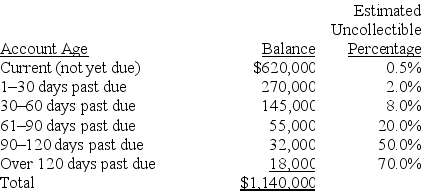A company uses the aging of accounts receivable method to estimate its bad debts expense.On December 31 of the current year an aging analysis of accounts receivable revealed the following:
 Required:
Required:
a.Calculate the amount of the Allowance for Doubtful Accounts that should be reported on the current year-end balance sheet.
b.Calculate the amount of the Bad Debts Expense that should be reported on the current year's income statement,assuming that the balance of the Allowance for Doubtful Accounts on January 1 of the current year was $41,000 and that accounts receivable written off during the current year totaled $43,200.
c.Prepare the adjusting entry to record bad debts expense on December 31 of the current year.
d.Show how Accounts Receivable will appear on the current year-end balance sheet as of December 31.
Definitions:
Departmental Overhead Rates
The overhead costs charged to specific departments based on their respective activities or consumption of resources.
Machine Hours
The total number of hours that machinery is operating during a certain period, often used in costing and operational efficiency analysis.
Oak Paneling
Decorative interior panels made from oak wood, often used in furniture, flooring, and wall covering.
Departmental Overhead Rates
The allocation of indirect costs to specific departments based on relevant cost drivers, aiding in more accurate product costing and pricing decisions.
Q8: A company factored $30,000 of its accounts
Q9: The overstatement of the beginning inventory balance
Q64: An advantage of FIFO is that it
Q83: Norman Co.had $5,925 million in sales and
Q124: All of the following are true of
Q126: As long as a company accurately records
Q142: The advantage of the allowance method of
Q149: Starlight Company has inventory of 8 units
Q166: A company's employees had the following earnings
Q223: The phrase capital-intensive refers to companies with